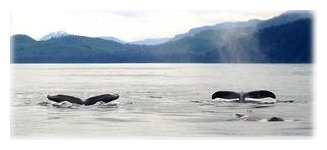
Listen from close by or far away with the Oceanphonics Hydrophone...
The Ocean is filled with sound
Why Oceanphonics?
At Oceanphonics we believe that every sound in the ocean is important. That means our whale watching hydrophone will increase the sound level automatically so that when marine life is not close by, distant sounds will be heard. What is fascinating is how mammal sounds echo and are reflected by the ocean floor, cliffs and rock formations. This creates a soundscape that draws the listener into a new world. Listen to whales, dolphins, porpoises...
Oceanphonics is a word we have created that describes the art of listening and even comprehending sounds underwater made by mammals and other intelligent ocean dwelling creatures. Phonics means "to hear, identify, and manipulate phonemes (a basic unit of a language's phonology)...which is combined with other phonemes to form meaningful units such as words..." Whale vocalization may be clearly heard by underwater microphones. Combined with these sounds are several other factors that whales in the vicinity use to understand the state of each other, both mood, distance, spacial surroundings, and even distance to prey. Here are the combined factors:

1. The underwater environment consists of an incompressible medium which carries sound much more readily than air. Vocalizing not only provides communication between animals, but also carries with it an echo that will intuitively convey distance to the ocean floor, surface or other large objects such as rock outcroppings or cliff faces.
2. Range finding clicks are generated by orcas or dolphins to comprehend the distance to prey or close objects. One ping will within a split second bring awareness of the distance and number of fish or other food sources that are being pursued. Other animals in the area will know that it is feeding time. During play periods orcas tend to vocalize more. Many researchers have attempted to parse and understand these sounds. The breaking down of vocalization into basic elements or phonemes to try and develop a phonetic understanding is a fascinating experience. Researchers have determined that the "language" of orcas differs between geographically separated pods.This acoustic experience may be heard by an underwater microphone called a hydrophone.

The Oceanphonics hydrophone has been uniquely optimized to receive mammal sounds so as to provide the listener with a truly fascinating soundscape.
The Unique Oceanphonics Hydrophone
Constructed with physical properties that allow the best reception of sounds made by mammals vocalizing underwater, a look at the internal structure of the hydrophone will reveal an internal air cavity. In the center of the hydrophone is the air cavity (white) allowing the best sensitivity to be rendered to the cylindrical microphone element (blue). Because there is air inside, there is also a weighted area (indicated by a grey coil) which keeps the hydrophone oriented properly when in the water.

Nature uses a similar method to sense sound underwater as water is a non ‐ compressible medium. Fish can “hear” or sense sound vibrations in the water by means of nerves down the sides of their body (the lateral line) in combination with a gas ‐ filled swim bladder. Sound vibrations are sensed by the fish between the water and air transition in their body.
The Oceanphonics hydrophone has been developed over 25 years with experience and experimentation. In addition to the method used to pick up sound as described above, the internal cavity also boosts mammal sounds by means of broad band resonance. Another feature of the hydrophone allows full protection of the sensitive element, located in the window behind the Oceanphonics label, not at the bottom where it could typically be damaged by rocks on the ocean floor or by being dropped on concrete. The cable contains a Kevlar strength member in the core, allowing complete strain relief of the internal conductors. A “soft eye” loop containing this strength member is used to attach the hydrophone to your boat. Proper attachment of this cable will allow for many years of commercial service.
  To view the Oceanphonics catalog, prices, and to order, please click HERE To view the Oceanphonics catalog, prices, and to order, please click HERE |